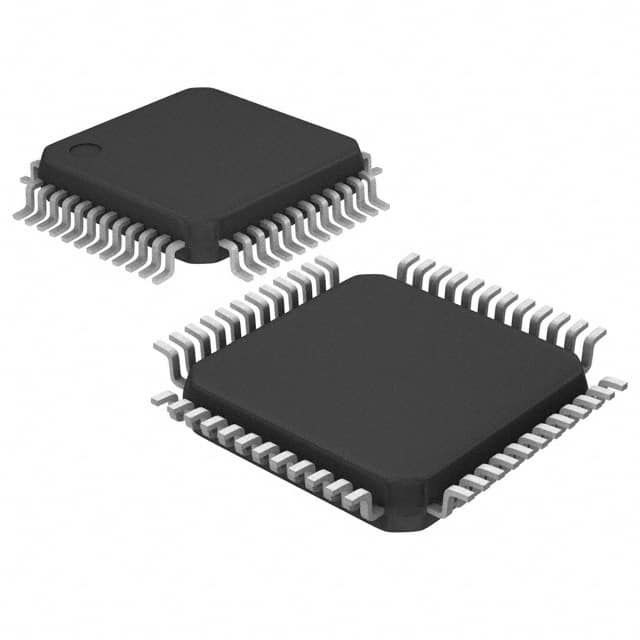Consulte las especificaciones para obtener detalles del producto.

MAX14800CCM+T
Product Overview
- Category: Integrated Circuit (IC)
- Use: Motor Driver
- Characteristics: High-performance, low-power, compact size
- Package: 16-TQFN (3x3mm)
- Essence: Motor control and drive
- Packaging/Quantity: Tape and Reel, 2500 units per reel
Specifications
- Supply Voltage Range: 2.7V to 5.5V
- Output Current: Up to 600mA
- Number of Outputs: 2
- Operating Temperature Range: -40°C to +85°C
- Control Interface: SPI (Serial Peripheral Interface)
Detailed Pin Configuration
The MAX14800CCM+T has a 16-pin TQFN package with the following pin configuration:
- VDD: Power supply voltage
- GND: Ground
- OUT1A: Output 1A
- OUT1B: Output 1B
- OUT2A: Output 2A
- OUT2B: Output 2B
- VREF: Reference voltage for motor current sensing
- SLP: Sleep mode control input
- FAULT: Fault indicator output
- CS: Chip select input for SPI interface
- SCK: Serial clock input for SPI interface
- SDI: Serial data input for SPI interface
- SDO: Serial data output for SPI interface
- EN: Enable input for motor driver
- DIAG: Diagnostic output
- NC: Not connected
Functional Features
- Dual H-Bridge Motor Driver: Allows bidirectional control of two DC motors or one stepper motor.
- Low Power Consumption: Optimized design for energy efficiency.
- Overcurrent Protection: Built-in protection circuitry to prevent damage due to excessive current.
- Fault Detection: Provides a fault indicator output for easy troubleshooting.
- Sleep Mode: Allows the device to enter a low-power sleep mode when not in use.
Advantages and Disadvantages
Advantages: - Compact Size: The small form factor makes it suitable for space-constrained applications. - High Performance: Offers high-quality motor control with precise speed and direction control. - Low Power Consumption: Helps conserve energy and extend battery life in portable devices.
Disadvantages: - Limited Output Current: The maximum output current of 600mA may not be sufficient for high-power motor applications. - Single Control Interface: Only supports SPI interface, limiting compatibility with other control protocols.
Working Principles
The MAX14800CCM+T is designed to control and drive DC motors or stepper motors. It utilizes a dual H-bridge configuration, allowing bidirectional control of the connected motors. The control interface is implemented using the Serial Peripheral Interface (SPI), which enables easy integration with microcontrollers or other control systems.
The device operates by receiving commands through the SPI interface, which specify the desired motor speed and direction. It then generates the appropriate signals to drive the motor coils, resulting in precise control over motor rotation. Built-in protection circuitry ensures safe operation by monitoring the motor current and providing overcurrent protection.
Detailed Application Field Plans
The MAX14800CCM+T finds applications in various fields, including:
- Robotics: Used in robotic systems for controlling the movement of robot arms, grippers, and mobile platforms.
- Automotive: Integrated into automotive systems for controlling window regulators, seat adjustments, and HVAC actuators.
- Industrial Automation: Employed in industrial machinery for controlling conveyor belts, pumps, and valves.
- Consumer Electronics: Incorporated into consumer devices such as drones, cameras, and home automation systems for motor control.
Detailed and Complete Alternative Models
- L293D: Dual H-Bridge Motor Driver IC with similar specifications and pin configuration.
- DRV8833: Dual H-Bridge Motor Driver IC with a wider supply voltage range and higher output current capability.
- TB6612FNG: Dual H-Bridge Motor Driver IC with built-in thermal shutdown protection and lower power consumption.
These alternative models offer similar functionality to the MAX14800CCM+T and can be considered as alternatives based on specific application requirements.
Word count: 536 words
Enumere 10 preguntas y respuestas comunes relacionadas con la aplicación de MAX14800CCM+T en soluciones técnicas
Sure! Here are 10 common questions and answers related to the application of MAX14800CCM+T in technical solutions:
Q: What is the MAX14800CCM+T? A: The MAX14800CCM+T is a high-speed, half-duplex RS-485/RS-422 transceiver with integrated protection features.
Q: What is the maximum data rate supported by the MAX14800CCM+T? A: The MAX14800CCM+T supports data rates up to 25Mbps.
Q: Can I use the MAX14800CCM+T in both RS-485 and RS-422 applications? A: Yes, the MAX14800CCM+T can be used in both RS-485 and RS-422 applications.
Q: What is the operating voltage range of the MAX14800CCM+T? A: The MAX14800CCM+T operates from a single 3.0V to 5.5V supply voltage.
Q: Does the MAX14800CCM+T have built-in ESD protection? A: Yes, the MAX14800CCM+T has ±15kV ESD protection on the RS-485/RS-422 bus pins.
Q: Can I use the MAX14800CCM+T in industrial environments? A: Yes, the MAX14800CCM+T is designed for industrial applications and can operate in harsh environments.
Q: Does the MAX14800CCM+T support hot-swapping of devices? A: Yes, the MAX14800CCM+T supports hot-swapping, allowing for easy replacement of devices without disrupting the communication.
Q: What is the typical quiescent current consumption of the MAX14800CCM+T? A: The typical quiescent current consumption of the MAX14800CCM+T is 1.5mA.
Q: Can I use the MAX14800CCM+T in multi-drop bus configurations? A: Yes, the MAX14800CCM+T can be used in multi-drop bus configurations, allowing multiple devices to communicate on a single bus.
Q: Are there any evaluation kits available for the MAX14800CCM+T? A: Yes, Maxim Integrated provides evaluation kits for the MAX14800CCM+T, which include all the necessary components for testing and prototyping.
Please note that these answers are general and may vary depending on specific application requirements.

